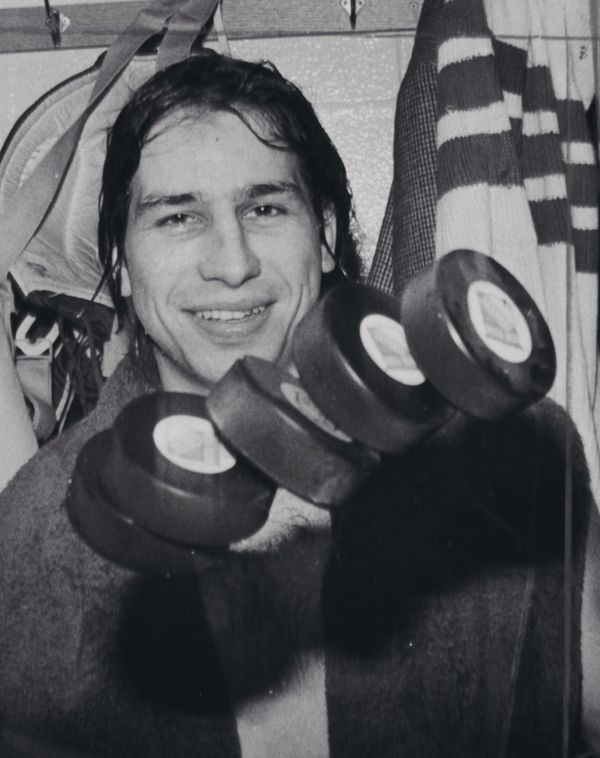New York’s Favorite Smurf
Star-crossed hockey enigma Mark Pavelich died last week. He follows Bobby Suter as the second Miracle Man to have passed, and with it, yet another baby-boomer icon is gone. Unlike the gregarious Suter, Pavelich was understated, lurking in the shadows, skating into the light only when the puck was dropped.
To your average hockey fan, Pav’s offensive gifts were unappreciated until he after the Miracle on Ice, when he joined the New York Rangers. He spent five years playing at the World’s Most Famous Arena, averaging close to a point-a-game in five years with the Blueshirts, a 5’8” center in the rough and tumble NHL. The soft-spoken kid from Minnesota’s Iron Range couldn’t be ignored after his five-goal game for the Blue Shirts, one that splattered his name on the back cover of the Gotham tabloids.
But to Minnesota hockey lifers, Pav was “The Show,” long before he made it to the Miracle on Ice and the NHL. “He was the Gretzky of Minnesota minor hockey,” said John Burke, a Duluth native now coaching in Sun Valley, Idaho.
Another Sun Valley skater knew the Pavelich youth hockey legend firsthand. “I was on a very good bantam team with [future Olympian] Phil Verchota in Duluth,” said Tim Jeneson, who starred at Division II Saint Scholastica in the late 1970’s. “We went up to Eveleth and played Pavelich’s team, when he was an underage bantam. We lost 21-1, and we were a good team. Pav had nine goals.”
According to both Burke and Jeneson, that was business as usual for Pavelich.
Hi college numbers his final year at UMD are also breathtaking: over two points per game, 31 goals in 37 games. It was a no-brainer for Herb Brooks to slot Pavelich onto a line with fellow Iron Rangers John Harrington and Buzzy Schneider in Lake Placid, where they picked up the nick-name “cone-heads.”
In the NHL, Pav was one of the Rangers beloved “Smurfs,” a line of undersized clutch scorers. It was always more convenient to lump him within a group, because as an individual, Pav kept to himself.
His death has generated more stories than actual fact, Homeresque tales of the man’s outrageous scoring, his isolation, and his mental health challenges. Pav’s Duluth pals who moved on to Sun Valley shared stories both first and secondhand, like how he received a blow to the head so hellacious on the pre-Miracle tour that Herb Brooks thought Pav would never play again. Pav started the next night.
Another classic tale emerged from the pre-Olympic tour took place in November, 1979, just after the opening of firearm hunting season in Minnesota. Team USA was scheduled to play Pav’s old team Minnesota Duluth, a happy homecoming at the old DECC Center. Coincidentally, presidential candidate George H.W. Bush would be making the trip to glad hand the fresh-faced U.S. Olympians. The only problem was that Pav went AWOL, missing all the photo ops the day before. USA Hockey officials were justifiably distressed, though Herb Brooks was not shocked when Pav showed up at the rink an hour before game-time.
Pavelich had no problem entering the old Auditorium with a familiar wave to his pals in the Zamboni entrance, but he was immediately accosted by George Bush’s Secret Service detail. They were understandably freaked out from the sight of Pav in his blood stained jeans with a rifle slung over his shoulder. Just Pav being Pav.
He was always more comfortable deep in the Minnesota bush than in the company of fellow man. His best buddy in college was Mike Jacques, who transferred across town from UMD to play at St. Scholastica. The UMD guys always preferred partying at Scholastica; it was predominantly female, having recently transitioned from an all-girls school to co-educational. But Pav wasn’t really into chatting up the co-ed’s, he would stand around with Jacques and Jeneson, studying the label on his beer.
Minnesotans marvel at how Pavelich could make himself disappear in the off-season, portaging his canoe north from lake-to-lake, getting further and further away from any semblance of civilization. He was pure Minnesota: a guy who acquired his hockey creativity in the free space of outdoor ice; a hunter/fisherman who became one with nature during his lengthy forays into the land of 10,000 lakes.
His life was also an example of a square peg in a round hole: a Minnesota loner thrust into a starring NHL role on Broadway. He was intensely loyal to his Olympic Iron Range line mates, but balked at the high-profile Miracle on Ice reunions. He never felt comfortable embodying the team that pulled off the greatest victory of the 20th century.
One final insight courtesy of the Sun Valley puckers from Minnesota. Multiple sources were aware that Pav was preparing to live out his final chapter in northern Idaho. He had located a plot of land near Couer d’Alene, where he was going to build a refuge away from strangers and their prying eyes. Jeneson and Burke shared the anguish with so much of the Minnesota hockey community when they heard the news of Pavelich’s tragic passing. To this day, they remain in awe of the undersized Pavelich’s prodigious talent, one that dazzled on hockey’s grandest stages: the halcyon days of the WCHA, the Miracle on Ice, and at the World’s Most Famous Arena. R.I.P. Pav.





No comments:
Post a Comment